


Aqueous chemistry of titanium
Metallic titanium is very corrosive resistant, but concentrated hydrochloric acid is capable of dissolving this metal, but very slowly. The solutions, formed in this way have a beautiful color.
Aqueous titanium ions can be really beautiful bright colors. In the +3 oxidation state, titanium is deep violet/blue, in the +4 oxidation state, titanium ions only can exist in strongly acidic media and in such situations they are colorless. With hydrogen peroxide, a deep red complex is formed, which on dilution looks orange or even yellow. This complex is quite stable. Even a moderately strong reductor like sulphur dioxide only is capable of reducing the hydrogen peroxide in the complex slowly.
In this experiment all described colors and phenomena are shown in detail.
![]()
![]() Required
chemicals:
Required
chemicals:
-
titanium metal, coarse powder or fine filings
-
concentrated hydrochloric acid, approximately 30% by weight
- dilute hydrogen peroxide (3 - 6 % by weight)
- sodium sulfite
- sodium persulfate or ammonium persulfate
![]() Required
equipment:
Required
equipment:
-
test tubes
-
rubber stopper
-
glass bottle, erlenmeyer or beaker
![]() Safety:
Safety:
- concentrated hydrochloric acid is very corrosive and gives off fumes, which are very noxious
![]() Disposal:
Disposal:
- Only very small amounts of titanium come into solution (just a few tens of mg). This small amount can be flushed down the drain with a lot of water. The other chemicals also can be flushed down the drain.
![]()
Procedure for performing the experiment
![]() Take
a small amount of titanium metal, just a pinch on the tip of
a spatula, and add a few ml of concentrated hydrochloric acid. Initially no
reaction can be observed.
Take
a small amount of titanium metal, just a pinch on the tip of
a spatula, and add a few ml of concentrated hydrochloric acid. Initially no
reaction can be observed.
![]() Gently
heat the contents of the test tube, while swirling it slowly and carefully. Keep
on heating, until some effervescence can be observed. Then stop heating. The
titanium metal now slowly dissolves in the acid.
Gently
heat the contents of the test tube, while swirling it slowly and carefully. Keep
on heating, until some effervescence can be observed. Then stop heating. The
titanium metal now slowly dissolves in the acid.
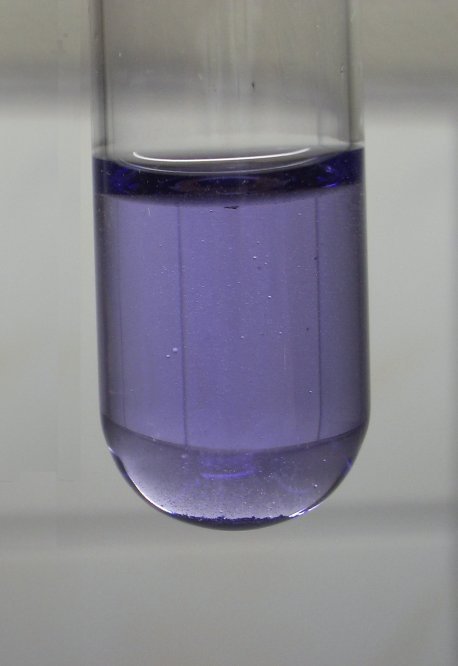
![]() Stopper the test tube loosely. The slowly produced hydrogen gas must be allowed
to escape, but one should assure that no large amounts of fresh
air can enter the test tube. This is because titanium in the +3 oxidation state
is fairly sensitive to oxidation by oxygen from the air. Wait for a while and
every few tens of minutes shake the liquid with the
small titanium particles gently. You'll see a violet/blue color developing, but
this is a slow process. Several hours later a light violet/blue color can be
observed, as shown in the picture.
Stopper the test tube loosely. The slowly produced hydrogen gas must be allowed
to escape, but one should assure that no large amounts of fresh
air can enter the test tube. This is because titanium in the +3 oxidation state
is fairly sensitive to oxidation by oxygen from the air. Wait for a while and
every few tens of minutes shake the liquid with the
small titanium particles gently. You'll see a violet/blue color developing, but
this is a slow process. Several hours later a light violet/blue color can be
observed, as shown in the picture.
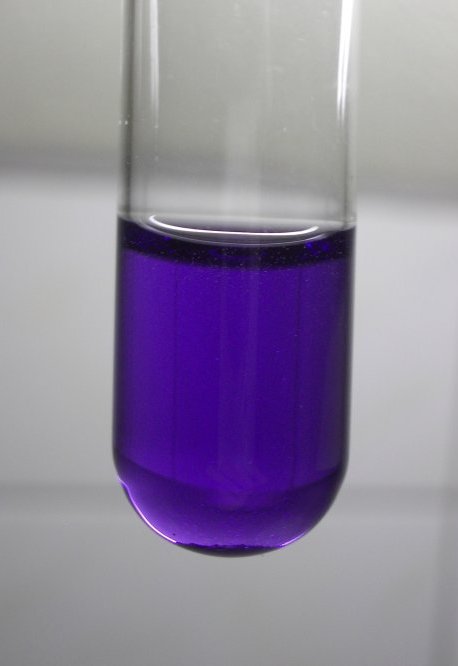
![]() Let stand for one or two days, while loosely capped, such that the hydrogen is
allowed to escape from the test tube. After one day the liquid has a beautiful
violet/blue color. After two days this color is really deep, like indigo. This
is shown in the picture at the left.
Let stand for one or two days, while loosely capped, such that the hydrogen is
allowed to escape from the test tube. After one day the liquid has a beautiful
violet/blue color. After two days this color is really deep, like indigo. This
is shown in the picture at the left.
![]() Take
approximately ⅓ of the indigo liquid and dilute with the same volume of water
and then add some hydrogen peroxide to this, drop by drop, until a steady deep
red/brown color is observed. When the test tube is shaken, then the glass will
be tinged with a yellow/orange color. The pictures below show this deep red
compound and a dilution of this.
Take
approximately ⅓ of the indigo liquid and dilute with the same volume of water
and then add some hydrogen peroxide to this, drop by drop, until a steady deep
red/brown color is observed. When the test tube is shaken, then the glass will
be tinged with a yellow/orange color. The pictures below show this deep red
compound and a dilution of this.
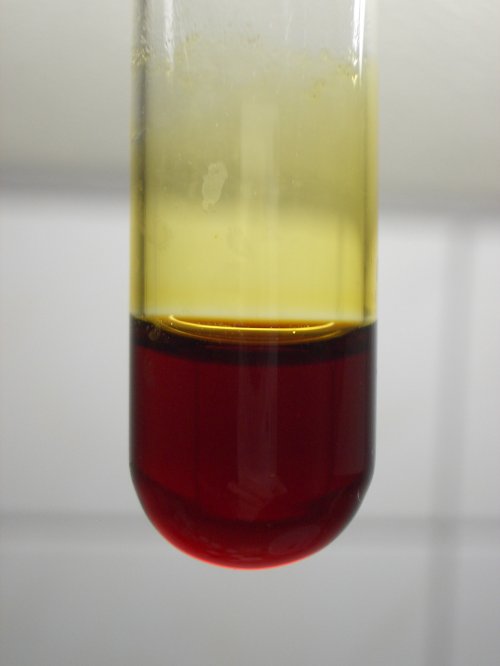
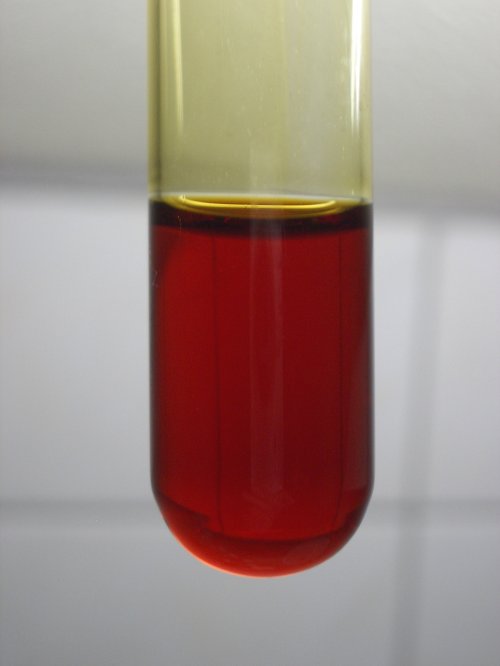
![]() Dilute
the remaining part of the indigo liquid with the its volume of water and then
add some sodium persulfate or ammonium persulfate. The liquid slowly becomes
colorless. This shows the oxidation of titanium in the +3 oxidation state to
titanium in the +4 oxidation state and it shows that without a complexing agent
like hydrogen peroxide, titanium in the +4 oxidation state is colorless.
Dilute
the remaining part of the indigo liquid with the its volume of water and then
add some sodium persulfate or ammonium persulfate. The liquid slowly becomes
colorless. This shows the oxidation of titanium in the +3 oxidation state to
titanium in the +4 oxidation state and it shows that without a complexing agent
like hydrogen peroxide, titanium in the +4 oxidation state is colorless.
![]()
The deep red liquid is added to 50 ml of water in an erlenmeyer. This results in a red/orange liquid. Dissolve a spatula full of sodium sulfite in a separate test tube with a few ml of dilute hydrochloric acid (approximately 10% HCl by weight), and add the contents of this test tube to the erlenmeyer as well.
Now the erlenmeyer contains as active compounds the titanium-peroxide complex, acid and sulphur dioxide (from the sulfite). The sulphur dioxide slowly reduces the peroxide in the complex and leaves titanium (IV) in solution, which is colorless. Titanium (IV) cannot be reduced to titanium (III) by sulphur dioxide, otherwise the violet/blue color of titanium (III), as shown in the pictures above, should appear.
Reduction of the complex is slow. The sequence below shows a set of pictures, taken at different times. The time from left, with the initial red/orange liquid to right is approximately 10 minutes. The temperature was around 15 °C during this experiment.
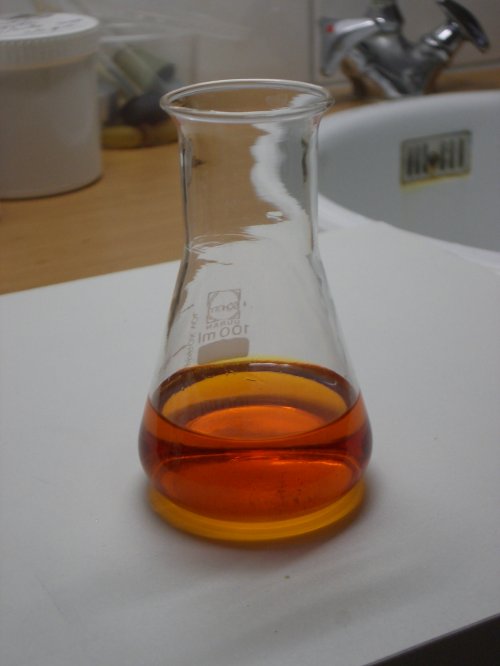
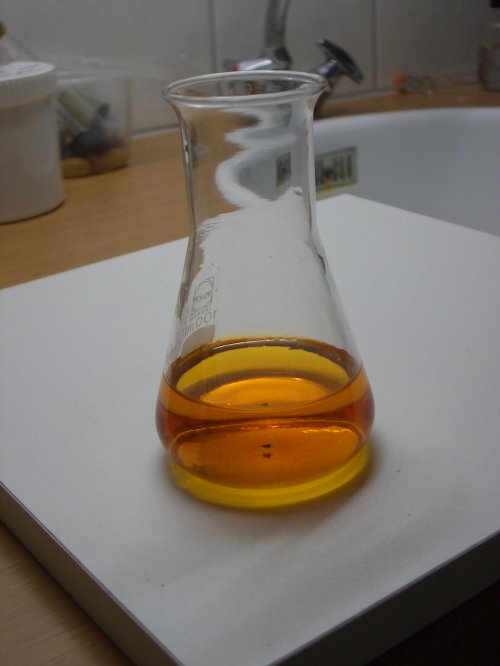
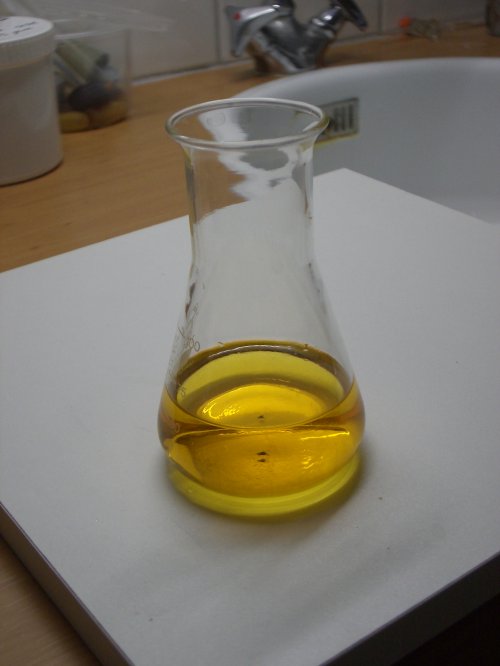
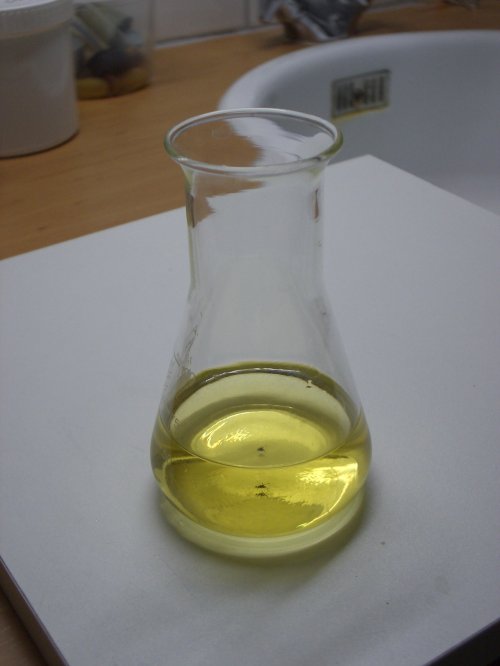
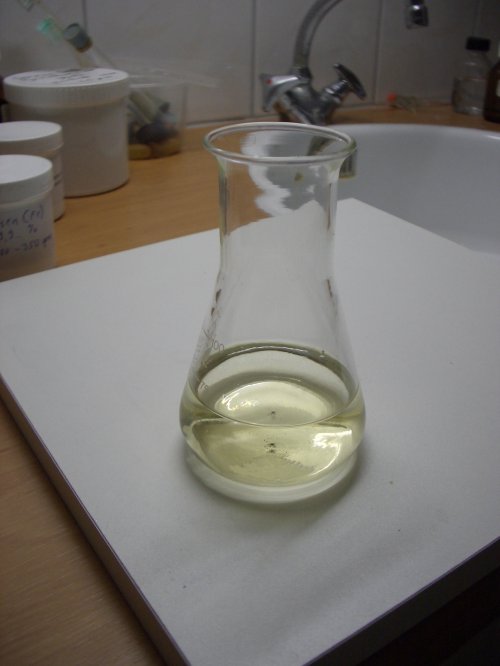
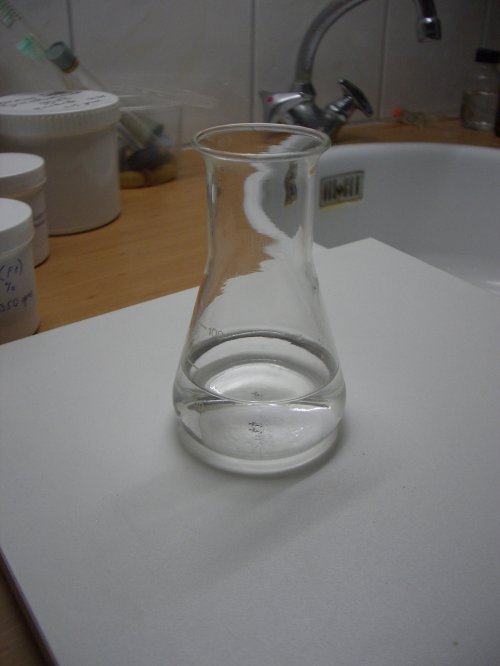
![]()
Discussion of results
Titanium metal is very corrosion resistant in an oxidizing environment, in spite of the fact that it is relatively electropositive. Nitric acid for instance is not capable of dissolving the metal. The reason for this probably is that the metal forms a passivating oxide layer in an oxidizing environment. In a non-oxidizing acidic environment, the metal, however is slowly attacked. Concentrated hydrochloric acid slowly attacks the metal, according to the following equation:
2Ti(s) + 6H+(aq) → 2Ti3+(aq) + 3H2(g)
The Ti3+(aq) ions have a deep violet/blue color.
On addition of hydrogen peroxide, the titanium in the +3 oxidation state is oxidized to titanium in the +4 oxidation state. The latter in turn forms the deep red complex with hydrogen peroxide.
Aqueous titanium in the +4 oxidation state exists as a dipositive cationic species, which only remains in solution at very low pH. Whether the cation is TiO2+(aq) or Ti(OH)22+(aq) is not yet clear. At higher pH, a precipitate of hydrous TiO2 is formed.
When hydrogen peroxide is added to an acidic solution with titanium (IV) in it, then the red cationic species [Ti(O2)(OH)]+(aq) is formed. Here the peroxo ligand O22- is connected to the metal through both of the oxygen atoms, hence a better formula for the complex is [Ti(η2–O2)(OH)(H2O)x]+.
In the second part of the experiment, the peroxo-complex of titanium is broken down slowly by sulphur dioxide and plain colorless titanium (IV) is in solution again.